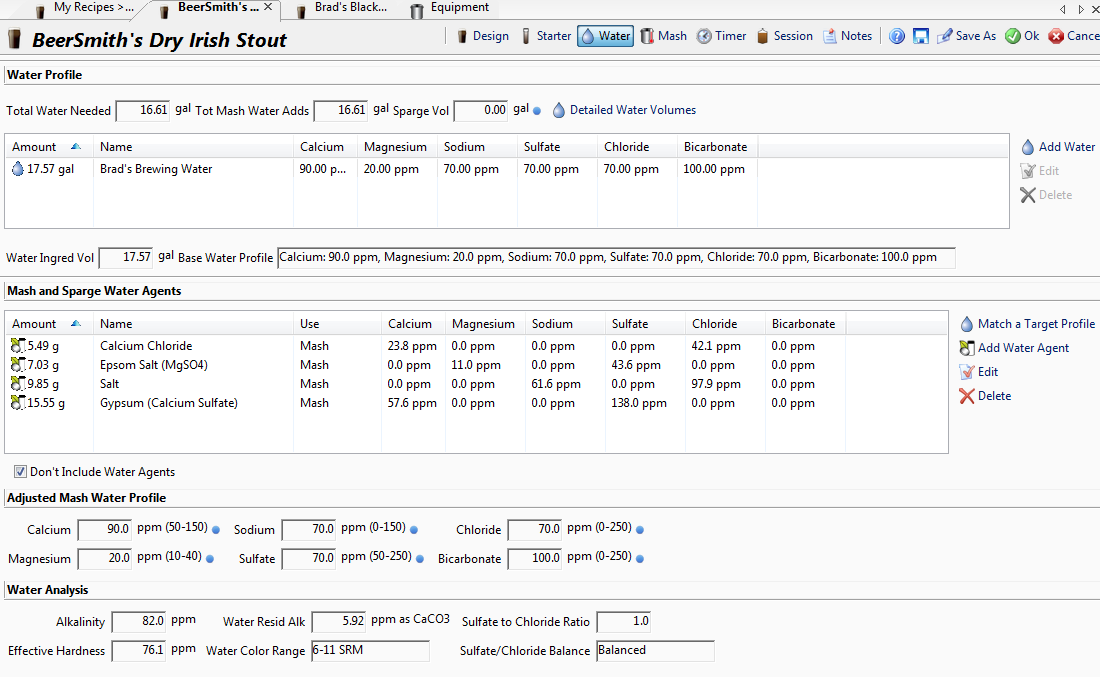

Without adding this data, your mash pH will not be calculated correctly. Enter your grain names, weight, type of grain, and estimated lovibond numbers in the prompts. Next scroll down and open the tab labeled Grist Info, and choose the checkbox for malt bill.Note: if your Calcium, Magnesium, or Sodium levels do not match the water target profile, whether too high or too low, that is perfectly OK! We want to be most accurate with our Chloride and Sulfate levels, and their ratio.Get as close as you can to the target profile. Next add an amount in grams to the Calcium Chloride (CaCl) prompt until you hit the correct number for CaCl shown above.Again, the delta should be a green number as close to 0 as possible, and the black number should be as close to the water profile number as possible. Next add an amount in grams to the Gypsum (Ca+2 SO4) prompt until you hit the correct number for SO4 shown above.The delta should be a green number as close to 0 as possible, and the black number should be as close to the water profile number as possible. Next add an amount in grams to the Epsom Salt prompt until you hit the correct number for Mg+2 shown above.The delta should be a green (or red) number as close to 0 as possible, and the black number should be as close to the water profile number as possible. Start by adding an amount in grams to the Canning/Other Salt (NaCl) prompt until you hit the correct number for Na+ shown above.We like to use kosher salt, or flaked sea salt. Be sure that your Sodium Chloride has NO IODINE in it! Iodine will kill yeast and inhibit fermentation. The main 4 minerals you will be using is Calcium Sulfate (Gypsum), Calcium Chloride, Magnesium Sulfate (Epsom), and Sodium Chloride (Canning/Other).You have the option of adding all your salts to the mash water (click the checkbox) without adding anything to your sparge water, or treating your entire volume of water beforehand. Choose a water profile from the table at the bottom of this page, and enter the numbers where prompted.If using the very not recommended chlorine/chloramine ridden municipal Orleans Parish water profile, grab it from the water profile table below and enter the minerals where prompted.If using Deionized water, the numbers for calcium, magnesium, chloride, sulfate, and bicarbonate will all be 0. Enter your water amounts that you use on brew day where prompted as Total Water Volume, Mash Water, and Sparge Water.Below is a brief step by step showing how to use the invaluable Brewer’s Friend Water Tool. Deionized water is great because it’s water in its purest form two hydrogens and one oxygen. When Brewstock brews any type of beer, we build all of our brewing water from scratch using deionized water and minerals purchased at Brewstock. Scroll to the bottom of the page to find a large chart of water profiles.īrewstock uses the Brewer’s Friend Water Tool when making our beer, we think you should too! There are many great other tools out there as well, not limited to BeerSmith, BeerTools, and BrunWater, but we think the most intuitive and user friendly option is Brewer’s Friend. Your 15% Double Dry Hopped Imperial Bourbon Barrel Aged Coffee Pastry Wheat Wine is still 85% Water! We believe water is the most important aspect of any beer no matter what you’re brewing.


 0 kommentar(er)
0 kommentar(er)
